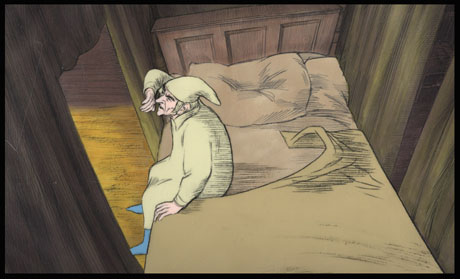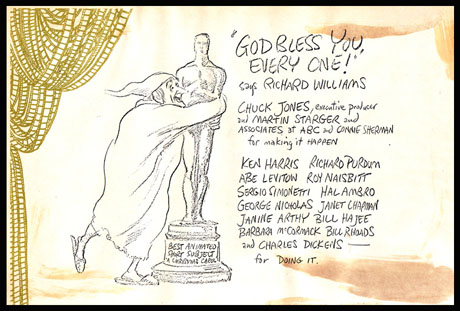
“How did they do that?” is a question that, as an audience, we don’t ask much anymore. This is especially true in animation, particularly in our digital age, where computer animation has made the impossible possible on screen, all the time.
But “How did they do that?’ applies to every frame of director Richard Williams 1971 animated adaptation of Charles Dickens’ A Christmas Carol.
The late, great animation legend created a wholly original version of the much-adapted Christmas classic that is one of the few film versions that truly feels like Dickens text come to life.

A large part of this is the fact that Williams and his Team based the look of the film on the work of artist John Leech, who had provided the illustrations for the very first published edition of A Christmas Carol in 1843.
Although animated, the images in Williams’ A Christmas Carol, which tell the all too familiar tale of miserly Ebenezer Scrooge and his Christmas Eve visit from several Ghosts, has a sketched appearance, making the entire twenty-five minutes of the short film take on the appearance of art work that has come to life. Added to this are watercolor-like backgrounds, some of which (like those during a scene at a lighthouse surrounded by seagulls in silhouette), move along in a dream-like fashion. The result is mesmerizing.
These images are coupled with techniques that give the film, at times, the feel of a live-action production. To use such tactics today in animation is somewhat easily accessible.
Such was not the case, of course, in 1971, when A Christmas Carol was produced. Yet, there are scenes that seem to involve camera pans, or sequences in which the camera seemingly circles around the characters. Much of this involved not just animating the characters, but the backgrounds as well and in different sizes as they move toward and away from the frame. The hand-crafted quality, coupled with a three-dimensional feel in these moments, is downright tactile.

In one scene early in the film, as Scrooge walks along a darkened hallway toward his apartment, all we see is his face and hand illuminated by the candlelight he holds. The images move toward and then past the camera in a shot that is so seamless that one may not even be humbled by its creativity until it has passed.
Scenes like this also lend an eerie undertone that pervades the entire film. This truly is “A Ghost Story of Christmas,” as Dickens initially subtitled A Christmas Carol. Sequences are purposefully unnerving, such as the frail, hollow-eyed skeletal figures of Ignorance and Want, who live under the cloak of The Ghost of Christmas Present.
There are also moments of subtle animation, such as when the hand of The Ghost of Christmas Future, pointing toward Scrooge’s grave, hesitates momentarily, as Ebenezer pleads with it.
William’s A Christmas Carol was also a “Carol Reunion” of sorts. Actor Alistair Sim voices Scrooge and Michael Hordern provides the voice of Marley’s Ghost. Both performed the same roles in the 1951 live-action version, which many also claim as one of the best adaptations.

Richard Williams (left) with Chuck Jones
Also onboard the production was a triumvirate of animation legends and veterans of Warner Bros. Cartoons. Chuck Jones served as Executive Producer, while two artists, Abe Levitow (credited as “Guest Artist”) and Ken Harris (credited as “Master Animator”) who had worked with Jones for years, also contributed to A Christmas Carol.
The short film is another example of how Richard Williams continually expanded the boundaries of animation throughout his career. He is most famous for directing the animation for Who Framed Roger Rabbit (1988), but his other projects through the years, include Raggedy Ann & Andy: A Musical Adventure (1977), the TV special Ziggy’s Gift, the infamous and much discussed The Thief and the Cobbler (1992) and his short film, 2015’s Prologue.
While some of these projects may have had issues with story, the artistry they provide are stunningly original visions, which have never been duplicated or attempted by others in animation.

A Christmas Carol was originally shown as a TV Special on ABC on December 21st, 1971 and was thought to be so strong that it was subsequently released theatrically. With this, the short found itself eligible for an Oscar nomination and eventually went on to win the Oscar for Best Animated Short Film. This caused a controversy at the time, leading the Academy to change the rules for shorts after this, where they had to be produced specifically for a theatrical release.
Next year marks the 50th anniversary of this beautifully animated film, crafted with beautiful artistic care. But don’t wait for next season, if you’ve never seen it, seek out Richard Williams’ A Christmas Carol now. You will no doubt find yourself asking, “How did they do that?”
- An Eye for A Classic: The 60th Anniversary of “Mr. Magoo’s Christmas Carol” - December 22, 2022
- A Very Merry Mickey: The 70th Anniversary of “Pluto’s Christmas Tree” - December 19, 2022
- A Fine French Feline Film: The 60th Anniversary of “Gay Pur-ee” - December 12, 2022


 December 18th, 2020
December 18th, 2020  Michael Lyons
Michael Lyons  Posted in
Posted in  Tags:
Tags: 






